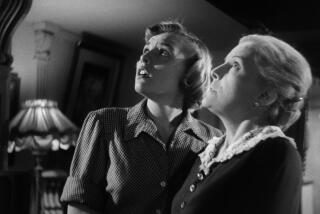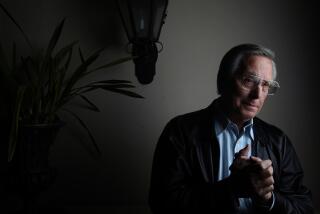ALDRICH RETROSPECTIVE AT UCLA
How lucky Robert Aldrich was to have Edward G. Robinson as the star of his first film, “The Big Leaguer” (1953), which, screening at 7:30 p.m. Thursday at UCLA Melnitz, launches a retrospective of the late director’s work. It’s a sentimental baseball yarn in which Robinson was cast as John B. (Hans) Lobert, a former third baseman who founded the New York Giants’ training farm in Melbourne, Fla. It’s a pleasing reminder of what a great screen actor Robinson really was--and in a role far removed from the gangster portrayals that have secured his place in film history.
Playing with “The Big Leaguer” is the picture that may well be Aldrich’s very best: “Kiss Me Deadly” (1955), a film noir classic based on the Mickey Spillane novel. As Mike Hammer, toughest of private eyes, Ralph Meeker gives a lift to a distraught Cloris Leachman and the corpses commence piling up. “Kiss Me Deadly” is one of those mysteries so convoluted that even at the end you’re not quite sure how it all adds up. “Kiss Me Deadly” is the film that established Aldrich’s hard-edged style and reputation for cynicism. Following the screenings there will be a panel discussion on Aldrich’s career headed by writer-director Abraham Polonsky. Phones: (213) 825-2581, 825-2953.
There are wonderful character actors and L.A. locales in “Kiss Me Deadly,” and the same is true for another celebrated film noir of the ‘50s, Stanley Kubrick’s “The Killing” (l956), which screens Wednesday at the New Beverly Cinema, 7165 Beverly Blvd. Both films, shot in a gritty black and white, are in fact invaluable records of the now-leveled Bunker Hill with its seedy turn-of-the-century splendor and its quaint Angels Flight, for 60 years billed as the world’s shortest railway.
Based on Lionel White’s thriller “Clean Break,” “The Killing” remains not only one of Kubrick’s most satisfying films but also one of the most “perfect” heist movies ever made. Although celebrated for its intricate construction involving fragmented time and shifts in point of view (which were in the White novel), “The Killing” endures above all because of its superlative performances. Masterminding a race track robbery is stoic loser Sterling Hayden (in a role similar to the one he played in “The Asphalt Jungle”). The standouts, however, are Elisha Cook Jr. as a nervous, henpecked track cashier and Marie Windsor as his brassy gold-digging wife. Phone: (213) 938-40838.
“Hito Hata: Raise the Banner” (1980), the first full-length film dealing with the history of the Japanese-Americans actually made by Japanese-Americans, will screen Sunday at UCLA Melnitz at 7:30 as part of an Asian-American International Film Festival. A low-budget Oriental “Roots,” “Hito Hata” is first of all a tribute to the persevering Issei, the first generation of Japanese-Americans. Mako is cast as Oda, a sturdy octogenarian--or more--who came to California in 1910 to work on the railroads. “Hito Hata” was directed by Robert A. Nakamura and Duane Kubo from a story by Nakamura and others at Visual Communications, a Little Tokyo-based media company and archive.
More to Read
Only good movies
Get the Indie Focus newsletter, Mark Olsen's weekly guide to the world of cinema.
You may occasionally receive promotional content from the Los Angeles Times.










